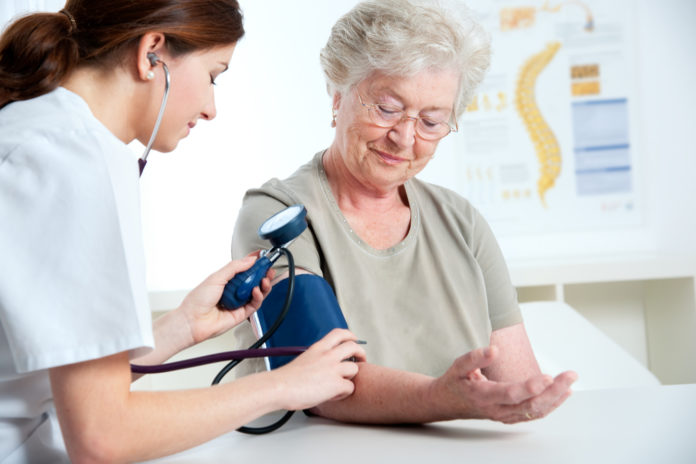What Is High Blood Pressure?
Formally known as hypertension, high blood pressure (BP) is when the heart forcefully pumps blood into the arteries. Blood pressure is at its highest when the heart beats and pumps out blood (systolic pressure) and falls when the heart is between beats and at rest (diastolic pressure). Consistent elevation in pressures can ultimately weaken and damage the blood vessels, subsequently leading to more serious heart and health consequences, including heart and kidney failure, heart attack, stroke, blindness, and aneurysms (small bulges formed in blood vessels). High BP is also broken into primary and secondary hypertension:
Primary High Blood Pressure
Also known as essential high blood pressure, primary high BP is the most common. Its development may gradually occur as age advances.
Secondary High Blood Pressure
Secondary high BP develops following a medical condition or certain types of medications. Once the cause is treated, blood pressure generally goes back within normal ranges.
In addition to advancing age and certain medications, extra risk factors of hypertension include inactivity, being overweight or obese, a family history of hypertension, prehypertension, smoking and drinking too much alcohol.
Know Your Numbers
Blood pressure readings are read from top (systolic pressure) to bottom (diastolic pressure) and read as systolic over diastolic. For example, if your blood pressure was 116/18, it would read “116 over 18.” Blood pressure is also labeled as mmHg, a measure of millimeters of mercury, a unit for measuring pressure. Categorizations of blood pressure include:
- Normal Blood Pressure: <120/80 mmHg
- Prehypertension: 120-139/80-89 mmHg
- Stage 1 Hypertension: 140-159/90-99 mmHg
- Stage 2 Hypertension: >160/100 mmHg
When it comes to a normal blood pressure range for elderly individuals, health experts have not yet united to reach a formal conclusion. The debate sparked in 2013 when a published report advised healthcare providers take a new approach to treat high BP in people over age 60. The report further encouraged treatment at 140/90 for adults aged 30 to 59 but starting at 150/90 for people aged 60 and older. This sparked great concern by the American Heart Association, as they worry intervening at a higher BP range puts individuals at a much greater risk. The AHA sticks to their current recommendation, to initiating treatment at 140/90 until age 80 then at 150/90 following. And according to the Mayo Clinic, treatment goals are less than 140/90 in a healthy adult under the age of 60 or have a diagnosis of certain diseases. In a healthy adult aged 60 or older, treatment goals are less than 150/90. Despite the conflicting agreements, seniors should still aim for a “normal” blood pressure less than 120/80 like all adults.
The Heartening Truth and Advice
Despite the “tug of war” occurring between organizations, all individuals deserve the chance to reduce their BP and their total risk of correlating disease states that accompany if left uncontrolled. Though the odds seem to stack up against well-managed blood pressure in seniors, there are certainly known routes to drive BP readings to a safe, normal level. Caregivers are in a central position to encourage a normal blood pressure for elderly, monitoring and encouraging the following:
Blood Pressure
Since overt signs and symptoms are absent in hypertension, it is important to start monitoring blood pressures and start paying attention to trends. Most accurate blood pressure readings are during relaxation periods, whether it be sitting or lying down. As a caregiver, encourage your loved one to use the restroom prior to the reading while restricting them from coffee 30 minutes and sitting down for at least five minutes leading up to the measurement.
Diet
Though a nutritious diet should be encouraged throughout all life stages, it can further support normal blood pressure in elderly. If blood pressure readings start to elevate, maintaining or adopting a well-balanced diet is recommended, commonly excluding these 10 foods. If needing or desiring additional diet assistance, Silver Cuisine delivers well-balanced, nutritious meals straight to seniors’ doorsteps!
Exercise
With a healthy lifestyle, further urges exercise! In the senior population, it is important to only encourage tolerable workouts to prevent injury. Whether it be a 30-minute leisurely walk or chair exercises using body weight, the most important piece is getting them active. Find more regarding the importance of health and fitness for seniors here.
Weight Loss
Following a healthful diet and partaking in regular excess can ultimately foster weight loss, subsequently lessening the likelihood of high blood pressure. It is absolutely imperative to monitor weight loss in the elderly population, though. Seniors are at risk of losing precious mass, so urge valuable protein sources to discourage muscle loss and encourage fat loss.
Substance Abuse
If your loved one smokes, try to encourage smoking cessation. Although alcohol may fit into a balanced diet, encouraging its moderation can further offer blood pressure control.
Medications
Nonetheless, sometimes a healthy lifestyle cannot lower blood pressure levels. In these sort of cases, a primary care physician may prescribe medication to assist in its reduction.






